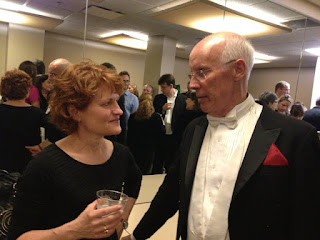May concerts, more than those in any other month, can have an especially emotional tinge to them, as it is the last time we see some of our colleagues for a while. If someone retires, it might be that we don’t see them ever again, in the orchestra at least. It is with that emotional tinge that we say goodbye to principal trumpet Cathy Leach. Her grace, class, and chops set the pace for the KSO’s brass family for more than 30 years. She will remain a faculty member at UT, and continue to perform with the Stiletto Brass Quintet.
One of my favorite memories of Cathy is of my first year here, 1986. I found out quickly that she was from Vermont, one of the states in the Red Sox Nation, from which I hail. That was the year, you may recall, when the Red Sox snatched defeat from the jaws of victory at the hands of the NY Mets. During the World Series we were rehearsing Verdi’s Rigoletto, with then-maestro Robert Lyall on the podium. During breaks, I made a beeline to the trumpet section, where Cathy was watching the games on the world’s smallest portable TV, about a 4" diagonal measure screen. This was way before the advent of Smartphones. I was just so tickled that here in Dixieland, there would be anyone who cared about the Red Sox enough to bring a Watchman to work.
After the Friday night Rite of Spring concert, there was a small reception backstage for Cathy. Here are a couple snapshots.
Here is Cathy and violinist Norris Dryer, no doubt giving her some sage advice.
The Rite of Spring trumpets, from left Tina Erickson, Sarah Chumney Fellenbaum, Sean White, Marc Simpson, Cathy, interloper Sam Chen (aka principal trombone, here playing bass trumpet).


